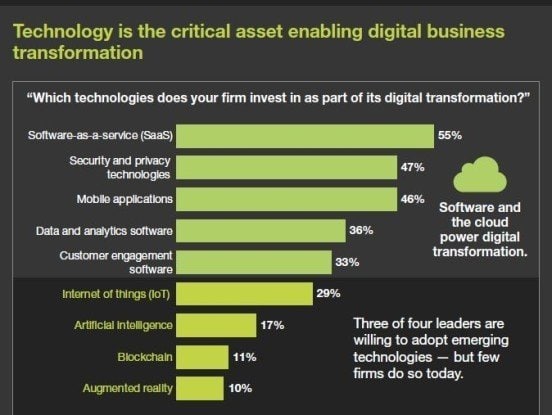Global players as well as small businesses are currently undergoing a digital transformation. Two recent surveys thoroughly examined the status quo of digital transformation 2018. Here you can read more about the most important findings.
“we think companies could exert a little more willpower using technology to do a better job for customers.”
Ted Schadler
This is how Forrester’s vice president and principal analyst summarises a current survey carried out by his own market research company regarding the status of digitalisation in 1600 companies in North America and Europe. The specialist also believes that the potential of new technologies has not yet been exploited by companies. Some of the findings underpin his argument:
Status of Digital Transformation 2018 in Companies
Responding to the question, who in their organisation is responsible for digital transformation, 37% of the interviewees named the CIO, followed by the CEO (24%) and Chief Digital Officer (18%). However, 30% of the survey participants would like to create a new position, which takes charge of transformation.
Of course, one appointed person is not enough and therefore 52% of managers stated that initially an innovation-friendly culture would have to be created to implement digital transformation. 39%, however, felt that digital platforms were crucial for successful digitisation.
What investments are made to be ahead with regard to digitisation? According to Forrester, companies rely in particular on Software-as-a-Service (55%); technologies for security and data protection (47%) as well as mobile applications (46%) are also given high importance.
With regard to the challenges of digital transformation, security concerns (31%) were most commonly stated; however, 23% believe it is the company culture and 20% see a lack of technology skills as the biggest challenge.
Digital Transformation as an Ongoing Process
While 56% of the interviewees indicated that their company is currently undergoing transformation, 15% stated they are still in the evaluation phase, while another 7% are already making progress. By contrast, 21% of the senior managers surveyed responded that for them the digitisation process is completed. Schadler comments these statements with scepticism – according to the analyst’s view, change will remain a permanent state and transformation will never be entirely achieved. Not least because customer requirements will always force companies to continuously evolve.
Digitalisation in medium-sized Businesses
Even smaller companies have already noticed the pressure to constantly adapt to new technologies. Here, digitalisation is well underway. In February 2018, the IUBH International University in cooperation with Allfoye Management Consultancy GmbH, the All for One Steeb AG and the European Institute for Leadership and Transformation interviewed in total 121 senior managers of medium-sized businesses regarding their digitisation strategies to get an idea about the current state of digitisation.
It is very positive that already 82.7% of the interviewed medium-sized businesses state that digitisation is part of the business strategy, however, only 37.6% also perceive it as a dominant factor in their strategic direction.
A clear trend can be recognised with regard to industry sectors: In almost all areas of digital transformation 2018, manufacturing acts slower than trading and service companies. However, it also needs to be noted that many processes of skilled crafts and trades businesses can only be digitised in part.
Digitisation as Opportunity – but, Internal Factors Slow Down Medium-Sized Businesses
Around 97% of the surveyed companies perceive digital transformation as an opportunity and therefore approach it decisively: 86.8% have already implemented relevant projects, whereby with medium-sized businesses this refers in particular to conventional IT areas, such as hardware and software and less to the development of new company structures and processes.
In contrast to medium-sized companies, where security concerns are the biggest challenge, it is mainly internal factors that hamper the way to digitisation. 48.1% of those interviewed see a lack of communication of senior management with employees as a decelerating factor, 40.8% complain about a vague utility of the projects towards digitalisation. According to All for One Steeb, this is presumably due to a lack of experience, whereby the potential for cost savings is often underestimated. Technical difficulties were only mentioned in third place by those interviewed (40.2%).
Conclusion on the Digital Transformation 2018
Meanwhile almost all companies have recognised the potential of digital transformation and see digital change as an opportunity. The majority has already initiated processes to adapt their own company to the new technical opportunities and requirements. They are faced with some challenges, such as security concerns. With medium-sized businesses, digital transformation is particularly hampered by a lack of communication on the part of senior management.
Image sources:
- Image 1: unsplash.com
- Image 2: Forrester
Sources:


